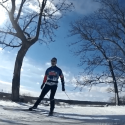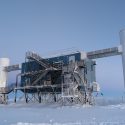Photo gallery At UW–Madison’s Antarctic outpost, they take this kind of weather in stride
Temperatures in Madison rivaled those in Antarctica on Wednesday and Thursday, prompting the city to all but shutter its doors. Even the university took the rare step of closing. But for researchers at UW–Madison’s IceCube project, an enormous particle telescope built in the ice beneath the South Pole, it was just another day at the office with temps well below freezing — like they are most days. Two IceCube staff members have to stay at the observatory year-round to help maintain it, and these “winterovers” find creative ways to pass the time. This year’s winterovers, Kathrin Mallot and Benjamin Eberhart, ran a half-marathon around the pole earlier this month. They’re also installing new equipment while the sun still shines overhead 24 hours a day. As Madison waits anxiously for spring, Mallot and Eberhart prepare to settle in for the long, sunless Antarctic winter.

The annual “Race Around the World” at the South Pole on Christmas Day 2018 — a fun run that circles around the South Pole, traversing all of the world’s time zones A. Greeley, National Science Foundation

IceCube winterover Kathrin Mallot running a half marathon at the South Pole in January 2019. Sasha Rahlin, National Science Foundation

IceCube winterover Benjamin Eberhard running a half marathon at the South Pole in January 2019. Sasha Rahlin, National Science Foundation

Hands and arms raised in celebration on completing the first 30-meter cable trench for a new radio antenna to support future expansions of IceCube in January 2019. Lu Lu, IceCube/National Science Foundation

Installing a new radio antenna to support future expansions of IceCube in January 2019. Max Renschler, National Science Foundation

UW–Madison scientist Delia Tosi throwing hot water into the air, where it immediately freezes, in January 2016. Delia Tosi, IceCube/National Science Foundation

A halo around the sun with the IceCube laboratory in the foreground in January 2019. Lu Lu, IceCube/National Science Foundation



